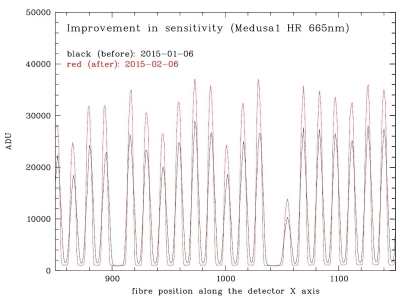The FLAMES GIRAFFE spectrograph is not kept at a controlled temperature, and thus, at the beginning of every observing block, GIRAFFE is re-focussed to take account of collimator temperature. The best focus position depends on temperature, grating and wavelength setting. The FLAMES Instrument Operation Team discovered that the software coefficients used to set the focus of GIRAFFE have changed since commissioning – presumably because of aging effects in the optics – and have measured and updated these coefficients. The updated values lead to a substantial increase in spectral resolution and sensitivity across all settings, particularly for the high resolution (HR) settings.
Improvement to FLAMES Spectral Resolution and Sensitivity

The improvement in resolving power can be seen in the figure from data taken after the end of January (update made on 2 February 2015). In this particular setting (H525.8A), the resolving power jumped from about 25000 to almost 32000, i.e., an increase >25%. It is expected that the update will also have a positive impact on the stability of the resolving power, as more recent data show. Further data are needed to confirm this improvement in stability, as well as to quantify the changes across all settings.
The changes will be implemented in the FLAMES GIRAFFE exposure time calculator (ETC) after a more thorough quantification of the improvements. Users who wish to combine data sets taken before and after 2 February 2015 may need to take these changes into account.

